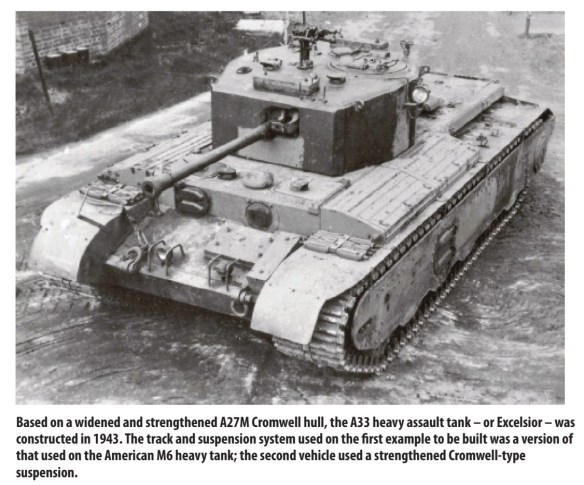The experience of the desert fighting of 1941-42, plus the appearance of US medium tanks in British service, led to a major revision of tank policy by the British General Staff in the fall of 1942 with the result that reliability and speed were now considered more important than heavy armour protection. Work was also initiated in developing a 75mm gun with “dual purpose” HE/AP capability, and it was for the first time that there was a need for a “universal” chassis capable of adaptation for the old “infantry”, “cruiser” and other AFV roles. Hopes were thus pinned on the A27 series, then in an advanced state of development and about to enter production. The A27M (Cromwell) with its Meteor engine had proved particularly successful on trials and was to go into large scale production. Since the Churchill tank was both slow and mechanically unreliable at that time, it was proposed to cease production of this vehicle in 1943 once Cromwells were available in adequate numbers. Churchill production facilities would then also be switched to Cromwell manufacture. As an interim measure, therefore, while a new “universal” chassis design was contemplated, consideration was given to using the Cromwell chassis as a basis for a heavier vehicle for the “infantry tank” role to replace the Churchill. Rolls-Royce drew up schemes for two possible developments on these lines. The A31 was simply a Cromwell with extra armour added while the A32 was a more ambitious adaptation with armour basis brought up to A22 (Churchill) standard and a new, stronger, suspension to compensate for the extra 4t (long) tons of weight this modification involved.
Designs for Assault Tanks seem to have dominated the middle years of World War II; A28, A31 and A32 were all assault tank designs based on the Cromwell, and although some lasted a while, none was ever built.
The question of designing heavy tanks came to the fore again in 1943, but, this time, it was driven by the imperatives of firepower and protection, and the resulting A33 heavy assault tank was an attempt to produce a standard or `universal’ tank chassis adaptable to either the infantry or cruiser roles. Two prototypes, sometimes described as Excelsior, were constructed by English Electric using a modifed A27 hull, up-armoured to a maximum thickness of 114mm… resulting in a combat weight of 100,800 lb (45,818kg). The engine was the by-now familiar Rolls-Royce Meteor, driving the rear sprockets through a five-speed Merritt-Brown transmission. Although both prototypes were armed with nothing more lethal than the 6-pounder (57mm) gun, it was envisaged that, if the tank went into production, this would be replaced by a 75mm weapon. The work was terminated in May 1944 with no further vehicles constructed.
A33 was slightly different in that two prototypes were built, again along Cromwell lines, but up-armoured and with a new style of suspension. Indeed, it seems to have been considered as a replacement for the Churchill, which at that time had failed to display its potential and was destined for replacement, if something suitable could be found.
Although it looked like the Cromwell it featured armour to a maximum thickness of 114mm and was powered by a Rolls-Royce Meteor engine driving through a Merritt-Brown transmission. It is reported as weighing about 45 tons, was armed with the 6-pdr (75mm) gun and had a five-man crew. The real differences were the suspension, which on Pilot A was similar to the American horizontal volute spring system, and the American-style tracks, covered by side skirting plates that stopped below the track guards rather along the lines of the American heavy tank M6. Pilot B on the other hand had a suspension known as the RL type, a joint design by Rolls-Royce and the LMS Railway, with British-style tracks, and in this case the skirting plates covered the top run of the tracks and met the track guards.
The idea was to send Pilot A to the United States in exchange for an American Locomotive Company T14 assault tank, so that they could be compared and the better one used as an assault tank by both armies. In the end Pilot A, which mounted a 6-pdr gun, was first subjected to two 1,000-mile trial runs across country in Britain, the second of which effectively wore it out. In the end it did not matter, as the Americans lost interest in the Assault Tank project while in Britain the ultimate success of the Churchill tank rendered it unnecessary. Pilot B, which mounted the 75mm gun, was relegated to the Tank Museum along with the T14, where they can both still be seen.
SPECIFICATION
Designation: Tank, Heavy Assault, A33
Crew: 5 (commander, driver, gunner, loader, co-driver)
Battle weight: 100,8001b Dimensions: Length 22ft 8in Height 7ft 11in Width 11ft 1 1/2in
Armament: Main: I x 75mm OOF Secondary: 2 x 7·92 cal Besa MG
Armour thickness: Maximum 114mm Minimum 20mm
Traverse: 360°.
Engine: Rolls-Royce Meteor V12 600hp
Maximum speed: 24mph Maximum cross-country speed: 12mph (approx)
Road radius: 130 miles (approx)
Fording depth: 3ft
Vertical obstacle: 3ft
Trench crossing: 7ft 6in
Ammunition stowage: 64 rounds, 75mm
Special features/remarks: Hull and turret basically the same as A27 series with added armour. Second pilot, with British tracks, had deeper side skirts concealing top run of track. Work on these vehicles was abandoned in May 1944.
Assault Tank, A33 “Excelsior”
